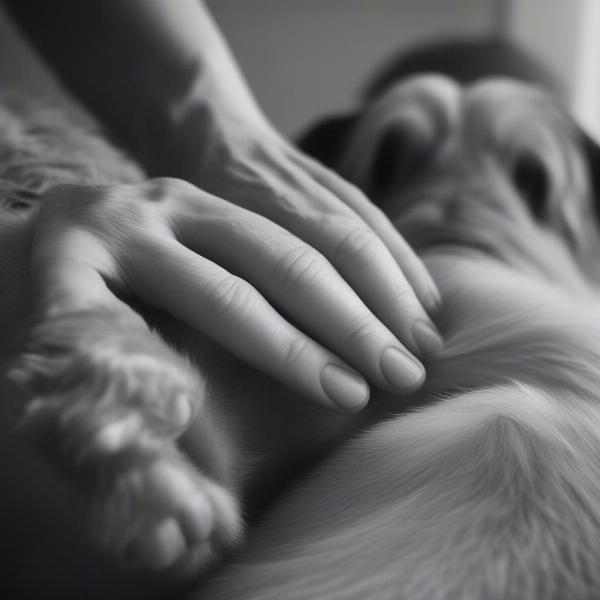A dog cut on paw can be a distressing experience for both you and your furry friend. Whether it’s a minor scrape or a deeper wound, knowing how to assess and treat the injury is crucial for preventing infection and ensuring a speedy recovery. This guide will provide you with practical advice on how to handle a dog cut on paw, from initial assessment to home care and when to seek veterinary attention.
Identifying the Severity of a Dog Paw Cut
The first step in treating a dog cut on paw is determining its severity. A superficial scrape might only require basic cleaning, while a deep laceration or puncture wound will need professional veterinary care. Examine the paw carefully, looking for signs of bleeding, swelling, embedded debris, or exposed bone or tendons.
 Examining a dog's paw cut
Examining a dog's paw cut
Cleaning and Disinfecting the Wound
Once you’ve assessed the cut, clean the area with lukewarm water and a mild antiseptic solution, such as diluted chlorhexidine or povidone-iodine. Avoid using hydrogen peroxide, as it can damage healthy tissue and delay healing. Gently remove any debris or dirt from the wound using clean tweezers.
Bandaging the Injured Paw
If the cut is minor, you can apply a clean bandage to protect it from further injury and contamination. Use a non-stick pad directly over the wound and secure it with a self-adhesive bandage. Ensure the bandage is snug but not too tight, as this can restrict blood flow.
When to Seek Veterinary Care
While minor cuts can often be treated at home, it’s important to seek veterinary attention if the wound is deep, heavily bleeding, or shows signs of infection, such as pus, redness, swelling, or a foul odor. Also, consult a veterinarian if your dog is limping or showing signs of pain.
Preventing Further Injury
Once your dog’s paw is bandaged, it’s essential to prevent them from licking or chewing the area. An Elizabethan collar (also known as a “cone of shame”) can be helpful in preventing this. Keeping your dog’s activity levels low during the healing process is also crucial.
Preventing Paw Cuts in the Future
Regularly check your dog’s paws for any signs of injury or wear and tear. Keep their nails trimmed to prevent them from catching and tearing. Avoid walking your dog on rough or sharp surfaces, and be mindful of potential hazards in your environment, such as broken glass or sharp rocks.
Conclusion
A dog cut on paw requires prompt attention and appropriate care. By following the guidelines in this comprehensive guide, you can help your furry friend recover quickly and prevent further complications. Remember to always consult with your veterinarian if you have any concerns about your dog’s health.
FAQ
-
What can I use to clean a dog’s paw cut? Use lukewarm water and a mild antiseptic solution like diluted chlorhexidine or povidone-iodine.
-
Should I use hydrogen peroxide on a dog’s cut? No, avoid hydrogen peroxide as it can damage healthy tissue.
-
When should I take my dog to the vet for a paw cut? Seek veterinary care for deep cuts, heavy bleeding, signs of infection, or if your dog is in pain or limping.
-
How can I prevent my dog from licking their paw wound? Use an Elizabethan collar (cone) to prevent licking and chewing.
-
How can I prevent paw cuts in the future? Regularly check paws, trim nails, avoid hazardous surfaces, and be mindful of potential dangers in the environment.
About ILM Dog
ILM Dog is your trusted resource for all things dog-related. We provide expert advice and practical tips on dog breeds, health, training, nutrition, grooming, and much more. Whether you’re a new dog owner or a seasoned pro, ILM Dog offers valuable insights to help you provide the best possible care for your canine companion. For expert guidance on dog health and wellness, contact us at [email protected] or call us at +44 20-3965-8624. Visit ILM Dog for more information on dog care, including how to treat a cut on a dog’s paw, find dog-friendly hotels, and discover fun dog-themed products like paw-shaped cookie cutters.